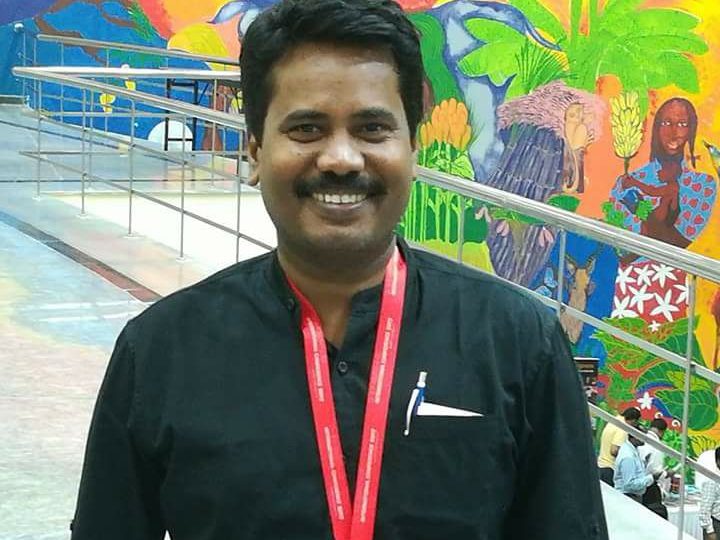Dr. Y. Srinivasa Rao
Nagas or Dravidians, the first migrant communities in India, are mythicised as Asuras or demons in a socio-political conspiracy of Aryan Brahmins. The word ‘Asura’ has many synonymous words such as Rakshasa, Rakshasi, Shankini, Dakini, Yakshi and Pisachi. Some of these have acquired everydayness as words of abuse and insult. Rakshasi and Rakshasa have become more popular than the rest. The educated employ the word consciously to refer to characters who allegedly possess demonic or violent traits. The uneducated, though not aware of the origin of the word, understand the meaning attached to it and employ it in their daily life. Hindu mythology popularised Asura characters and they have been adopted in dramas, ballads, stories, legends, folk songs and cinema. The educated Hindu ( who writes novels, stories, essays, songs on Hindu Gods and religion) knowing the origin and meaning of the word uses it with the intention of providing continuity and keeping the ‘mythical Asura alive’ because it serves the purpose of presenting pre-Aryan Dravidians as violent and demonic people which adds advantage to the Aryan Brahmans and Brahmanism. The uneducated, once taken into confidence, are gullible and believe whatever is written in the religious texts as true. In fact, it is in them that this belief stays much stronger than with the educated. Also, this usage is not limited to Hindus alone. Muslims, Jains, Chrtians, Budhists, Jains and people of all ages of all castes and communities consciously or unconsciously use the terms as swear words to verbally insult or humiliate someone. Even Dalit-Bahujan Adivasi (DBA) people, whose ancestors are these Rakshasa or Asuras, have been doing the same.
Rakshasa/Rakshasi are now common words in Indian languages and their usage is normalized to the extent that people would not know that they are using it to refer to the Dravidian race that is demonized by the Aryan Brhamans in the Vedic literature. These words have acquired terrible everydayness, and in the process camouflaged their real meaning to provide permanency to the meanings ascribed by Vedic Brahmanism to Rakshasa/Rakshasi as rude, barbaric, uncultured, murderer, killer, corrupt, unkind, unsympathetic, stone-hearted, member of gang rapists, monarch, dictator, authoritarian, villainous, ruthless, brutal, notorious criminal, unkind to parents and so on. Almost all negative virtues of the human male and female are attributed to these two words. This guaranteed humiliation to people who began to own the Asuras as their ancestors. Since they are a cultural and social minority in India, their anger against the usage of the word Rakshasa/Rakshasi is never taken seriously.
Indian literature, drama, cinema and even subaltern folk culture which adopted Hindu myths and puranas have presented the Sura/Asura binary as they were constructed in Hindu religious texts. Joti Rao Phule in his book Slavery was the first to challenge Aryan mythicization of Dravidians. It was then taken forward by Dr. B. R. Ambedkar and Periyar E. V. Ramasamy Naicker. Now, of course, the DBA intelligentsia have taken charge of it.
Apart from literature, Indian cinema has played a significant role in popularisation of Rakshasa/Rakshasi. From B. Vittalacharya to S. S. Rajamouli, a whole lot of magicians (upper caste/caste Hindu film directors) of the silver screen and the producers/production houses/companies owned by caste Hindu capitalists recreated the images of positive and powerful Suras and portrayed Asuras as heartless, demonic and violent. Indian mythological cinema then and now has been continuously impacting the minds of Hindus. One of the notable contributions of the mythological films was that they transformed Suras/Asuras existing in literary descriptions into ‘real life’ images. These films sought to establish and justify the Sura/Asura powers, merits and demerits and also how they look and perform their powers, their skin colour, beauty and ugliness and their ability to take different forms. Film actors who played Suras and Asuras have even been popularly viewed as equal to God and demonic figures respectively. From the beginning of cinema to today, there were many movies which portrayed mythicised Suras/Asuras as divine/devilish representations. Tiles of movies such as Mahisura Mardhini (Goddess killing Mahisasura), Keechakavadha (killing Keechaka), Asuravatham (Killing the demon), Asuravithu (Seed of demon), Asura Samharam (elimination of demon), Rakshasudu, Ravana and Ravanasure are plentiful in Indian Cinema. While the mythological cinema directly recreated images of Asuras based on the textual description with their ascribed negative, cruel, cannibalist and violent characters, the social cinema borrowed the characters and applied them to humans (cinema actors/actresses) to portray them or her as Rakshasa/Rakshasi.
We know that the Sura and Asura binaries are mythological, and that good and evil binaries are secularised versions of the same. We also know why a secularised version is produced. From a historical perspective, the demonization of Asura can be viewed as an Aryan conspiracy to camouflage the massacre of the pre-Aryan indigenous people and Sura-Asura narratives have been questioned by Adivasis, Dalits and Bahujans. How Dalits, Adivasis and Bahujans view their history and what objections they raise don’t matter in a country where even ahistory could be presented as history and historians from the dominant community determine what is history and what is not. Indian cinema, dominated by the upper caste/caste Hindus, is capable of perpetuating narratives which justify the hegemony of the Brahmanic culture. Time and again from Vitala Acharaya to Maruthupandiyan (director of Asuravatham – a Tamil movie) and Rajamouli, film makers have been producing narratives which provide continuity to the Sura and Asura binary. After seeing Asuravatham, teenagers and children who have not read much about the mythical Asura and their characters would come to a conclusion that Asuras were raping children and hence were evil and therefore killed by Gods in the myths and should be killed by heros or the police in cinema. This is how cinema unfairly normalises unjust mythological narratives with the intention of justifying Sura killing Asura. Most of the Hindus, both educated and uneducated, believe that Sura/Asura binaries are a cultural necessity for keeping the culture of Hindus alive. Any alteration in the narratives not only questions the hollowness of the metanarratives but also allows counter narratives to emerge as a challenge to the narratives of the dominant.
Therefore, Sura/Asura binaries (mythical or secular) would always be reproduced in various ways according to the changing time and context. S. S. Rajamouli, in Bahubali, made an unfair effort to reproduce the same binaries even if the story did not demand it. The Kalakeya is a tribe that never existed in the time frame in which he located the fictional story of Bahubali. On the one hand, Rajamouli gives the impression that he is making period movies and on the other hand claims that his stories are fictional. In Bahubali, he locates the plot in the early medieval times. The intention of the director was to glorify the Hindu kingdoms. However, doing that alone is not enough. He had to bring in an Asura tribe in the narrative which did not even suit the time and context. Then one would ask: What is the intention of bringing the Kalakeya tribe into the narrative? His sole intention was to show to the audience there were tribals (pre-Aryan hunter-gathering tribes) who were brutal and committed indescribable crimes on the civilised. Prior to Bahubali, film directors had brought many Asura characters onto the silver screen. However, compared to them, he had leverage with advanced cinema technology. I do not see any other purpose other than putting his imagination and graphic technologies to the best use to present the descriptive Asura on silver screen. According to Rajamouli, his fictional Kalakeya is an army of one lakh ruthless people who rape women at their wish and will. He also felt the need for creation of a new language, Kiliki, given the brutality and gore the tribe is ascribed with. The Aryans followed the same strategy of dismissing the pre-Aryan tribes as people of no language. In Bahubali, the screen presence of the Kalakeya tribe, action scenes they’re involved in and Kiliki language they speak helped the director to portray them as uncivilised brutal people with a funny meaningless language. Many aspects of Bahubali film have been debated and discussed, but the unnecessary inclusion of the Kalakeya tribe in the film is not discussed at all as it appeared to be normal to many. Thus, film directors like Rajamouli who do not spend much time on understanding the politics of Sura/Asura binaries take things for granted and invest all their intelligence and technology to provide strength to the culture of the majority to which they belong.
The custodians of the majority culture always focus on children as a means of providing continuity to their culture. Children in Hindu society get introduced into Sura/Asura binaries at an age where they would not comprehend what they are. From then on, they are continuously bombarded with images, stories, legends and myths on Sura/Asura binaries. Schools in India run by government and Hindu organisations made sure that children are taught about Sura/Asura narratives. In the domestic sphere, grandparents and parents believe it is their responsibility to impart their culture to children. In the public sphere, the general Hindu society shoulders the responsibility of promoting its culture among its members. All these agencies do not leave children to learn on their own. With their clear-cut agenda, these agencies target children of tender age and turn them into followers of what is said but not those who could raise questions on what they see and hear. If we examine Indian children’s television channels, we would understand why these channels are creating content based on Indian myths, legends and stories. Cartoons for children in India, for long, are dominated by the themes of western Europe, United States of America and Japan. Among many cartoon programmes, the superheroes content got the attention of kids. When Indian production houses were looking for Indian content for children, characters from Hindu mythology were readily available. All they had to do was reconfigure the powerful mythical characters into a child version. Bheema, well-built and strongest among Pandava brothers, is reconfigured as Chota Bheem (‘Chota’ means small or kid in Hindi), God Krishna reconfigured into little Krishna, Ganesha is re-configured into Bala Ganesha and other similar mythical cartoons like Krishna and Balaram, Hanuman, Ramayana: The Legend of Prince Rama, Pandavas, Ramayana, Mahabharata, Gotothkach: The Master of Magic, Luv Kush, Kalari Kids, Bheemayana, Krishna aur Kans and Arjun – The Prince of Bali are created with the sole intention of injecting Hindu mythology into innocent and unblossomed minds of children. The introduction of these programmes was viewed as replacement of the foreign cartoon programmes (Spiderman, Tom & Jerry) dubbed in Hindi and other regional languages. However, while most of the foreign cartoon programmes are secular, the Indian children cartoon programmes are religious. Like Indian cinema, the Indian cartoon industry too saw mythologies as the primary source material for making Indian cartoon content.
Most of these child Suras (Gods), even while being located in different contexts, have their powers and moral themes built into narratives that cannot avoid the presence of evil or Asuras/Rakshasas. However, what is quite intriguing is that the Asuras with whom these child Suras are fighting are not kids. They are adopted as they were from the mythologies. Their age, size and powers are not reduced. This is to say that since child Suras are gods, the Asura’s age, size and powers do not matter. Child Suras bash Asuras at will and wish. This appeals to the psyche of the children and most of them get hooked to these Child Sura cartoons. Six-year-old Vinayak Swaroop who was addicted to Child Sura cartoons became a big fan of animated Ram and says that he liked Ramji because Ram killed Ravana.[1] The creators of animated Asuras who fight against these child Suras have not set limitations for their imagination. Most of the animated Asuras appear as gross, zombie-like characters and Jurassic Park style monsters. The child Sura did not stop with being cartoons on screens. Pictures of them are printed on stickers, balloons, school notebook covers, T-shirts, keychains, sticking tattoos, coffee and tea cups and their statues are installed in children’s parks. There is no limit for their merchandise. The cartoons of Asuras do not get the same due respect. Some children, it seems, are moving away from these child Sura cartoons to Chinese Crayon Shin-Chin, Doraemon and Hindi dubbed versions of French Oggy and Cockroaches. It is found that the reason for such a change in the attitude in the children is that the foreign cartoons are funnier, located in urban settings and also universal in their appeal.[2] However, the degree of popularity of these child Sura cartoons have already made a huge impact on the minds of children. In their minds Sura and Asura exist forever and that provides continuity to these binaries. Children who are watching child Suras become aggressive and also religious. Around 36% of children who are watching Chota Bheem are behaving aggressively and around 55% of children follow religious practices portrayed in Chota Bheem.[3] Their appreciation of their cartoon child Suras for killing Asuras would be the same or probably much higher.
Even some of the educated DBAs do not understand where the word Asura came from and how it is being used by the upper caste/caste Hindus and are unable to avoid using it in their daily life and writings. DBA intellectuals wishing to claim the ancestry of rulers and people of Dravidian race out of historical necessity must avoid using these words. It is the responsibility of educated DBAs to educate their masses on the meaning of Rakshasa/Rakshasi and convince them to avoid these words in common parlance. Like non-Dalits, they are using Chandala, Mlecha, Rakshasa and Rakshasi, Surpanaka, Hidimbi in their daily life as swear words to humiliate, scold and point out how bad someone is. This is very unfortunate. They need to counter the negativity ascribed to Rakshasas in popular culture. This should be started by DBAs at individual, family and community level by liberating the word Rakshasa from ascribed negativity. It will happen when DBAs consciously stop using the word in everyday language with ascribed meanings or by countering the ascribed negativity by rewriting, re-reading or reinterpreting myths, puranas, legends and ‘history’.
Notes
[i] Rasul Balayya and Priyanka Mehra ( 2009, 13th November), Krishna Bheem are the New Cartoon Idols for Children, The Mint,https://www.livemint.com/Home-Page/JBz2x5nQumbMH5d3FRFIPI/Krishna-Bheem-are-the-new-cartoon-idols-for-children.html
[ii] S. Unnikrishanan (2016, 10th May) ‘Moving Focus from Indian Mythology’, The New Indian Express,
https://www.newindianexpress.com/cities/thiruvananthapuram/2016/may/10/Moving-focus-from-Indian-mythology-934816.html
[iii] Saranya and B. Balasubramanian (2016), “Depiction of Hindu Mythological Characters in Cartoons: A Case Study of ChotaBheem”, Indian Journal of Applied Business Economics Research, Vol. 14, No. 2, pp. 8515-16.
~~~
Dr. Y. Srinivasa Rao teaches history at Bharathidasan University, Tiruchirapalli, Tamil Nadu.










